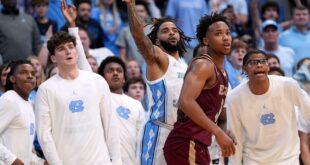• Part II of a five-part series ahead of the 2024-25 NBA season, chronicling how the league reached this era of parity and the key questions that remain. Part I |
Welcome to our new era of NBA parity, where one team in each conference is favored by Vegas to lap the field by several games.
Wait … what?
Yes, it’s true: Despite the seeming increase in parity over the last several years, and some structural changes that make it seem likely to continue, the Boston Celtics and Oklahoma City Thunder begin the season as heavy favorites in each conference.
So where are we, exactly, and how much parity is there? The discussion of parity in the NBA gets pretty nuanced once you start rifling through the weeds, and the cognitive dissonance of my introductory sentence is a perfect example.
Let’s start at the top and try to parse out what is happening right now, why it’s happening and whether it’s likely to continue.
What do we mean by “parity”?
Whether you think there is parity now, and how much, turns first on what exactly you mean by “parity.”
On one hand, talking about parity seems a little ridiculous when the Celtics just finished breaking the NBA, rolling to the third-highest scoring margin of the last half-century while winning 80 of their 101 regular-season and playoff games and cruising to the championship. We’ll circle back to them — and a budding dominant West team in the Thunder — in a little bit.
However, by a few different measures, we certainly have had parity for the last half-decade or so.
That’s especially true if you’re talking about dynastic parity, the idea that one or two teams aren’t ruling over the league every year. In the middle of the last decade, we had the Golden State Warriors and Cleveland Cavaliers play each other in four consecutive NBA Finals, but since then, we’ve been near the mathematical limit of parity as far as the playoffs are concerned.
In that time, we’ve seen six different champions — a new one each year — and nine different finalists. Another five have made the conference finals, giving nearly half the league a taste of late-May basketball in a little more than half a decade. And while 14 teams have made it that far at least once, only two teams (Boston and Miami) have made the conference finals more than twice.
Individually, nearly every franchise has had a rollicking roller-coaster ride of ups and downs (well, except Detroit). The Warriors, for instance, went from the 2019 finals to being the worst team in the league in 2019-20, then bracketed a championship season and a second-round playoff run with two other trips to the draft lottery. That’s quite a ride.
They’re not alone. The Heat played in four Play-In games and only had a top-four seed in the Eastern Conference once but made two NBA Finals and won eight East playoff series in that time. The Atlanta Hawks and Minnesota Timberwolves each were good enough to make a conference finals and bad enough to win the draft lottery in that same span. The Dallas Mavericks made a conference finals and an NBA Finals in a three-year window. In between, they missed the Play-In entirely.
We’ve also had more evenness in terms of regular-season dominance. Before Boston in 2024, we had six straight champions that failed to clear 60 regular-season victories*, and a few that were nowhere close. Before the Celtics this spring, we had three straight champions with the lowest win total for a champion since Miami (52) in 2006: Denver in 2023 and Golden State in 2022 had 53, and Milwaukee in 2021 pro-rated to just 52.4 (that season featured 72 games).
(*The Lakers pro-rated to exactly 60 in the COVID-19-pandemic-shortened 2019-20 season, although they might have let their foot off the gas if they’d been required to play the final 11 games.)
Concomitant with this has been the trend of a “fat middle” of teams winning between 40 and 52 games. It doesn’t seem mathematically possible, but 17 of the league’s 30 teams fit that description last season; a year earlier, it was 16. That, as much as anything, might boost the perception of parity, as it generates a Lake Wobegon-ish feeling that every team is above average. Dreaming bigger, when two-thirds of the league falls into “So you’re telling me there’s a chance…” territory, it starts to feel like the NFL.
Finally, there’s the example of playoff parity. The NBA, historically, has been an extremely chalky league when it comes to the postseason, and to an extent, that has still held — 44 of the past 45 champions have been seeded third or better, had at least a plus-3 scoring margin and won at least 52 games in the regular season.
However, something funky has been going on in the second round. In the last six postseasons of this “post-Cavs-Warriors” era, the team without home-court advantage has won 14 of those 24 second-round series, including upsets of teams that won 64 games (Dallas over Phoenix in 2022) and a pro-rated 63 (Miami over Milwaukee 2020).
That has underscored a more general randomness in the playoffs. The last half-decade has seen a No. 8 seed and two No. 5 seeds make the finals, and two No. 7 seeds and another No. 5 seed make the conference finals. Last spring’s Dallas-Minnesota West finals marked the fourth time in five years that neither of a conference’s top two seeds made it past the second round.
On the other hand, there’s the counterexample of what we might call struggle parity. Remember, parity isn’t just about the top of the league; it’s also about the bottom. And on that front, we haven’t had much parity at all.
The 2023-24 Pistons set an NBA record with 28 consecutive losses, and both the Pistons (14-68) and Wizards (15-67) had a worse record than any other team since the Sixers (10-72) in 2015-16. The Portland Trail Blazers, Charlotte Hornets and San Antonio Spurs joined them in the 60-loss club last season; seven teams lost at least 55 games.
Now you know where that “fat middle” comes from. The NBA is a zero-sum game where the wins and losses need to add up to 1,230 every year; you can’t have 20 teams win 40-plus unless the 10 that don’t are pretty awful. An economist might say the league’s Gini coefficient still doesn’t look so great when you account for the misery at the bottom.
So, to sum up where we stand: Revolving champions, less in-season dominance, more playoff randomness, a fat middle and a destitute bottom quarter of the league. Four of those five things you’d describe more as “parity” than not. So the trend line seems real.
Why is this happening?

Kareem Abdul-Jabbar and Bill Walton had individual success in the 1970s, but for different reasons, their teams didn’t dominate the NBA’s last era of parity. (Associated Press)
There’s a tendency to blame the new collective bargaining agreement for literally everything, and it may end up being a factor in prolonging whatever parity already exists. But remember, we’ve had only one season under the new rules, and with Boston jogging to a title, it arguably featured the least parity of the previous five.
It’s easy to look back with a clear eye at the greatest era of parity in the league in the mid-to-late 1970s to understand why we might be in the current phase. The best players from that era either had insufficient support (Kareem Abdul-Jabbar), were constantly injured (Bill Walton) or were playing in another league entirely (Julius Erving). Once the Celtics, Lakers and Sixers united multiple superstars under one roof, parity disappeared for the ’80s.
You can make the same case for the current era. Toronto, Denver, Golden State and Milwaukee were one-superstar outfits; Boston has multiple stars but no top-five player in the league. Only the 2020 Lakers fit the mold of a champion spearheaded by two elite stars. Since then, they’ve been hamstrung by the same rest-of-roster issues Abdul-Jabbar’s teams had in the 1970s.
However, there’s a second issue nobody talks about: The super teams failed. It wasn’t that the league wouldn’t let you build them; it was that the teams that succeeded in doing so still didn’t win — with those Lakers being a lone exception. The Brooklyn Nets tried to put Kyrie Irving, James Harden and Kevin Durant together and were a pinkie toe away from pulling it off, but the plane never flew after 2021. The LA Clippers got one healthy postseason and bonked it away in a collapse in the NBA bubble. Durant walked away from a super team in Golden State, and Irving arguably did the same in Boston.
And in 2023-24? The star talent in the league was so distributed that the 10 players who made first and second-team All-NBA came from 10 different franchises. That’s a far cry from the dynastic cores the Heat and Warriors built in the previous decade.
Will it continue?
That’s where the CBA comes in because it should have a big impact on dynastic parity in particular. Let’s back up a little and talk about the CBA, and start from this point: Every CBA isn’t just between the owners and players — it also governs the rules between all 30 owners.
In the 2023 negotiation, small-market owners extracted an important piece of flesh. The rules for the highest-spending owners became much harsher, to legislate away the financial advantage teams such as the Clippers and Warriors were lording over their lighter-spending counterparts. We’ve already seen much discussion about the impacts of the second apron — the payroll threshold set this season about $18 million above the luxury tax level — and in particular how it disincentivizes teams to stay above it for more than two seasons in five years.
Less discussed but equally relevant is a much harsher repeater penalty for teams who go into the tax three times in four years. That can pack a financial wallop for some clubs even before a second-apron penalty would hit. For example, Boston is headed for a staggering tax bill in 2025-26 if it doesn’t significantly pare down salary, and that will incentivize the Celtics to cut payroll even before any second-apron penalty hits a year later.
Ironically, however, it might produce less parity in the short term. If only a couple of teams can manage to put together an elite roster under the increased roster-building constraints of the CBA, while everyone else tops out at “pretty good” even if they have MVP-caliber building blocks … well, that’s how you might get a situation that looks an awful lot like this coming season.

The story of the greatest players in NBA history. In 100 riveting profiles, top basketball writers justify their selections and uncover the history of the NBA in the process.
The story of the greatest plays in NBA history.
Boston and Oklahoma City masterfully crafted together rosters that still work under the new rules thanks in part to rare circumstances: Boston by just beating the new-CBA buzzer with 2023 trades for Kristaps Porziņģis and Jrue Holiday, and Oklahoma City by having much of its top talent on favorable rookie contracts. Everyone else, it seems, is left to choose between being too top-heavy or too star-deprived.
Even the Celtics and Thunder, however, will have clamps on their most dynastic ambitions because of the apron and repeater rules. Under this CBA, most teams are likely to find themselves pushing their chips in for two-year windows of true contention, then retrenching to get below the second apron before having another go at it.
In the league’s eyes, that’s a feature, not a bug. The hope is that teams have to make difficult roster choices, that top-heavy teams with three superstars are mostly a thing of the past and that the result leads to more competitive balance. On many levels, that seems to be happening: The “fat middle” of pretty good teams and the relatively quick turnover of champions both seem likely to stay with us.
The playoff randomness? We’ll see if that isn’t also random, or if it has staying power; I’m not fully sold yet.
In any one season, however, the concept of parity may seem a bit more elusive. At the bottom end, it also can’t stop a team like last year’s Pistons from running into walls. More importantly to most fans, the larger framework can’t stop a team such as Boston from putting together a dominant two-year run, or an up-and-comer such as the Thunder from running away and hiding from the rest of the West (as it seems may happen in 2024-25).
So enjoy our brave new CBA world, everyone. We’re still learning all the impacts and consequences, both intended and unintended. But one of them seems to be that, whatever your definition of “parity,” the recent trend toward more of it is likely to drag on a while longer.
(Illustration: Meech Robinson: The Athletic; Photos: Jesse D. Garrabrant / NBAE; Hector Vivas / LatinContent; David Berding / Zach Beeker / Getty Images)
Source link
 meganwoolsey Home
meganwoolsey Home



